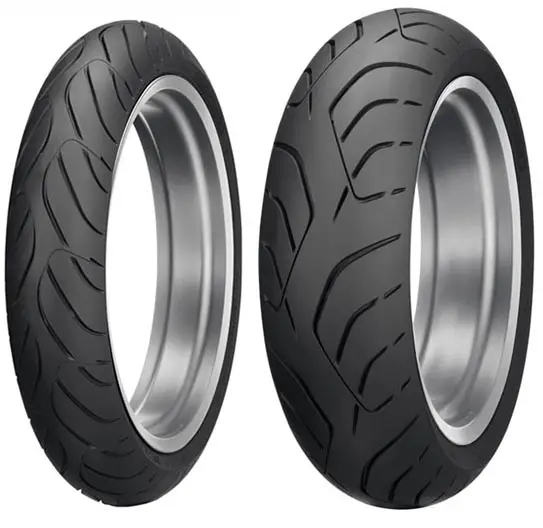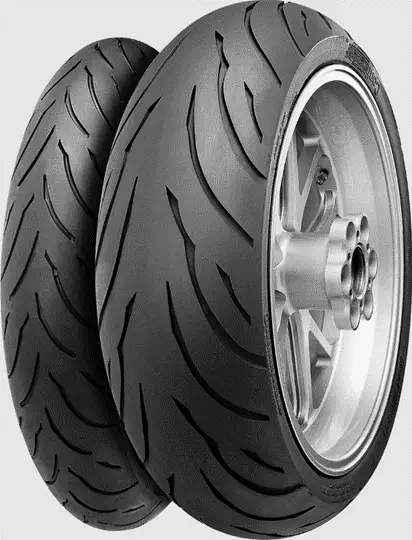Wet and slippery road conditions present a significant hazard for all motorists, and that factor is exponentially multiplied for motorcyclists.
Particularly when riding in heavy traffic situations, or even on deserted mountain roads, the ability to maintain traction and control is paramount.
Motorcycling is dangerous enough on a sun drenched day, and extra caution is called for in wet weather conditions.
A quality set of tires is always a wise investment.
Below, we’re going to take a look at some of the best all-weather tires that offer high performance in all conditions – including those rainy days when you still want to ride, or even have to.
Our shortlist picks for the top seven wet weather tires:
- Michelin Pilot Street
- Michelin Pilot Road 4
- Pirelli Angel GT II
- Dunlop Roadsmart III
- Metzeler Roadtec Z6
- Continental Motion
- Shinko 009 Raven
In this article, we’re concentrating exclusively on the best tires for wet weather. For a more all-around article regarding general tire life and how long your tires will last click here.
For most riders, selecting an all-around tire for both wet and dry weather is the most cost effective choice.
But maybe you live in Oregon, or jolly ole England or some other area where it rains more often than not? I don’t know… but there are certainly tires that lend themselves better to wet weather than others.
Michelin Pilot Street
The Michelin Pilot Street radial is likely the best real world selection from the company’s strictly sport lineup, with a combination of multiple deep rain grooves coupled with 100 percent all silica rubber construction.
Tire manufacturers in both the automotive and motorcycle market long ago discovered that mixing rubber with silica enhances grip in wet weather conditions.
Michelin was the first, beginning to produce rubber and silica composites in the early 1990s.
Silica is an element derived from the Earth’s surface. You probably refer to it by its more common name… sand.
In addition to added traction coefficient, silica also helps with keeping cutting and chunking of tires at bay.

Taking the page from Michelin’s book, most tire manufacturers now use some sort of silica component in producing all weather tires.
Michelin takes it a step further with the 100 percent silica construction with the Pilot Street.
Highly recommended… but…
This selection is intended as a pure sportbike tire.
An even better choice for most riders might be the one found below – it’s the tire from which the Pilot Street design was essentially lifted.
Michelin Pilot Road 4
The Michelin 4 is the most recent incarnation of the 2, which was a revered wet weather tire choice not that long ago. The 4 is even better.
Michelin claims that the Pilot Road 4 has a breaking distance of up to 17 percent less than rival offerings in wet conditions, and 24 percent shorter on very slippery painted surfaces.
The products also tested included rain tires from Dunlop, Metzeler, Pirelli, and Bridgestone, and were conducted by independent tire testing firm Dekra with both brand new tires and other tires that had already seen 3000 miles of use.
I’ve been on a long three-day street ride though the Deal’s Gap area of the Carolinas that unfortunately did include a long stint in a rainsuit, and was suitably impressed with the wet weather grip of the Pilot Road tires fitted to my Aprilla loaner in anticipation of rain along the route.

The big bonus is that these tires are marketed as sport touring tires, not pure sport tires.
Most riders would be hard pressed to tell that they aren’t on the softest rubber Michelin offers, and with the dual-compound composition the Pilot Road 4 will last all riders longer. Very strongly recommended.
Pirelli Angel GT II
Like Michelin, Pirelli motorcycle tires have racing DNA in their blood… errr… rubber compounds.
Although marketed as a sport touring tire, the tread design for the Angel GT II is a near direct lift from Pirelli’s Diablo wet weather racing tire, and will shed away the wet stuff as well as anything available on the market.
The design also features a variable chord count taken from the company’s more supersport oriented offerings.

The sport touring component is, again, a dual compound design for the rears that will ensure even wear and a long life even under sporting use.
Like its Michelin forebearers, the Angel GT along with nearly the entire line of Pirelli sportbike tires come with a liberal sprinkling of salt – silica, that is, for additional traction in the wet.
Also highly recommended.
Dunlop Roadsmart III
Dunlop’s pure sportbike tires are a bit dry weather oriented, and offer little in the way of water diverting tread.
They are excellent in the dry, but the designs tend to run more towards a road racing slick than an all weather tire.
So yes, there’s a bit of a pattern developing where we find ourselves most comfortable recommending a given company’s sport touring tires, while leaning towards the most aggressive of those offered.
Enter Dunlop’s Sportmax Roadsmart III.
This tire offers owners impressive high-mileage durability, but also features sportbike level grip while including excellent wet weather performance characteristics.
Like most of the tires in this overview, Dunlop utilizes a multi-compound design with higher mileage rubber in the center sections and softer compounds on the shoulders.
Dunlop says the composition includes a proprietary resin component that increases wet grip.

Available in an impressively wide selection of sizes, the Roadsmart’s cross groove tread pattern promises impressive ability to divert the water away while delivering maximum traction in wet weather.
Metzeler Roadtec Z6
The Roadtec Z6 from Metzeler is specifically designed for sporting performance in all weather conditions.
It features a front and rear tread pattern with swaying longitudinal grooves that is aimed first and foremost at consistent water drainage, even at aggressive lean angles during wet weather riding.
Like some of the other premium tires in this comparison but different, Metzeler has developed its own balance between carbon black rubber and silica it calls “Fine Carbon Matrix.”
The calling card for this FCM composite is quick adaptability from wet to dry conditions, covering a wide temperature range, for consistent response and precise corner entry.
The rear design includes a centrally located “slick stripe” for maximum acceleration with enhanced durability.

Metzeler tires are renowned for consistent feedback while riding aggressively, yet also offering a relatively plush ride for sportbike or sportbike tires through a combination of stiff belt construction for high speed stability coupled with a softer sidewall for comfort.
Recommended with confidence.
Continental Motion
The tires recommended above are all premium rubber, but they also come at relatively premium prices.
On our way out, we’re also going to suggest two other brands that might not quite compete with the above, but are more affordable and still offer a high level of all-season performance.
The first pairing we’d suggest to more budget conscious riders is Continental Motion tires.
Made from a formulated polymer compound that Continental says enhances longevity and durability, they are constructed with a zero degree steel belt design (for the rear) that offers a smoother ride without compromising traction.
The tires are designed to warm quickly, which is important in cold and wet weather conditions, and are entirely suitable for all season use for riders who operate their motorcycle year round or well into the later months of northern locales.

The only real caveat with running the Continentals in comparison to more expensive tires is that they are a touch heavier, which does mean they ride a bit harsher and can sometimes require more time for a tire technician to arrive at a proper balance.
Shinko 009 Raven
This is our most affordable recommendation. Although decidedly budget friendly, the Shinkos are durable and offer enough performance for most real world riders to consider.
Aramid belt construction is used to increase durability by reducing heat, and the Ravens will provide excellent bang for the buck through durability and longevity. The relatively unique diagonal tread design will shed the wet stuff with aplomb, making the Shinko an all around all weather tire well worth considering.

Michelin Power Rain
We’re going to end with a tire you specifically shouldn’t buy for your streetbike, as this perhaps counter intuitive selection is designed exclusively for track use and isn’t even legal for road use.
The thing is, a picture of Michelin’s Power Rain model is a perfect illustration of what you want in a rain tire – numerous deep grooves to channel the water away and leave the rubber more securely on the tarmac.

Deep longitudinal grooves run the circumference of the center groove, while the shoulders feature equally deep diagonal grooves to carry water away from the (albeit rather minimal) tread surface.
If only they were actually approved for legal street use, they’d be perfect for riding in monsoon conditions.
No, this one doesn’t count in our top seven, but is interesting to note none the less.
For Every Season, There’s a Reason
The tires recommended herein are all-arounders: Designed to work well in a huge variety of weather conditions from wet to dry, from hot to cold.
They can be used to ride all kinds of roads in nearly any situation, and beyond being good in the wet, they’re good anywhere and anytime.
Yes, more specific sporting rubber can offer a highly skilled rider somewhat higher levels of traction coefficient in perfect dry conditions, but expert level pilots have generally long since learned not to push their luck to track day levels while riding on the street.
In addition to their attributes for riding in the rain, the preponderance of tires above also offer a great degree more durability and longevity than pure sport tires, and will maintain their proper profile from center to shoulder for far longer.
All in, these are top shelf recommendations (with a couple of upper level if not top at the end) for anyone, anywhere.


